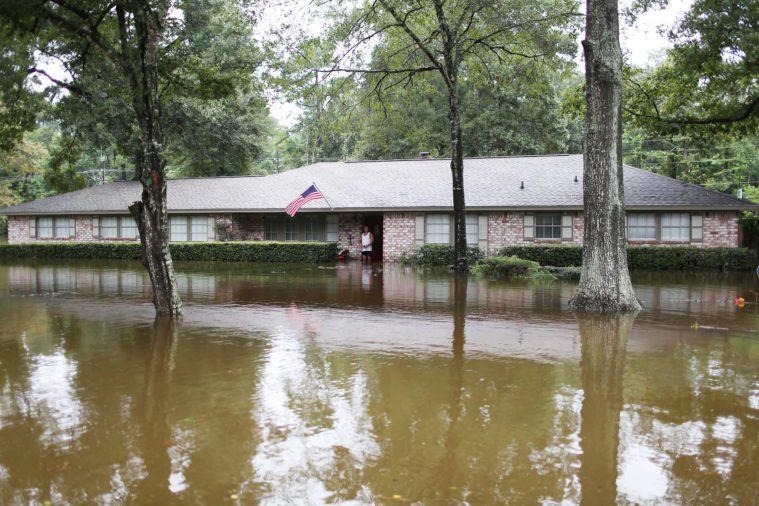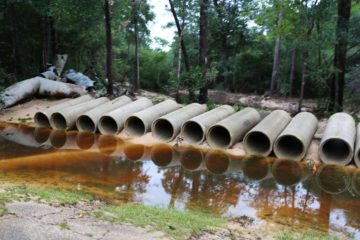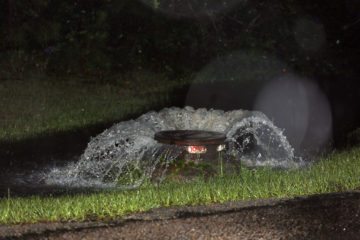
Costs for Rural Towns Surge after Hurricane Harvey Hits Water Systems
In Patton Village, some residents went weeks without access to clean drinking water, and now their sewer system is running on a “Band-aid.”


Patton Village had just started using its new $10 million wastewater treatment system when Hurricane Harvey wrecked it last month. Floodwaters fried the pumps’ circuitry and flooded a nearby municipal water well. Residents of one neighborhood went weeks without clean water. Repairing the wastewater plant could take months and cost hundreds of thousands of dollars that the town doesn’t have.
Located about 30 miles north of Houston in Montgomery County, almost a third of Patton Village’s 1,893 residents are below the poverty level. In fact, the new wastewater treatment system was the first in Patton Village’s history — until this year, the town lacked a comprehensive wastewater system, and the new facility had been hailed as a major sign of progress.
Leah Tarrant, mayor of Patton Village, said the damage was worst in the Peach Creek Dam and Lake Club neighborhood, where 90 homes and a drinking water treatment facility were flooded. The short rows of modest homes, lined with small gardens, pine and magnolia trees, were decimated.
“We had automobiles and motor homes that were literally sucked into the ground,” Tarrant told the Observer. “It looked more like a war zone than a flood zone.” It was three weeks after Harvey made landfall that clean water again could be provided to residents of the Peach Creek area.

Across the state’s coastal areas, raging water from flooded rivers snaked through rural areas and hit water systems hard, gumming up sewer mains with sand and mud, pushing raw sewage into waterways and rendering drinking water wells unusable. As of Monday, Texas Commission on Environmental Quality (TCEQ) data showed that 40 counties had issued 367 notices to residents that they’d need to boil water before safely drinking it. But even after water service is fully restored, cities could be holding the bag for millions of dollars in repairs.
In Patton Village, the town’s wastewater pumps are being run by “Band-aid” generators until $150,000 of new electronics can be installed, Tarrant said. The town also must pay about $200,000 to contractors who manually pumped Patton Village’s wastewater in the days directly following the storm. “Now we have so much cost,” she said.
Financial help may come in the form of a grant offered by the U.S. Department of Agriculture (USDA), which gives emergency funds to communities whose water infrastructure has been damaged in a disaster. Also, the Federal Emergency Management Agency (FEMA) helps cities pay to repair damage to publicly owned facilities. Tarrant has applied for both grants. “We are praying for USDA and FEMA assistance,” she said. “I believe we will get it, I just don’t know how soon.”
“If you look at a small community, the single largest capital investment that community will ever make is their water system,” said Nathan Ohle, executive director of the Rural Community Assistance Partnership (RCAP). After disasters, the nonprofit helps small and rural water systems assess damage and apply for grant funding. RCAP estimates that about 30 small and rural water systems in Texas sustained “significant” damage from Harvey. As a result, those communities — likely more than 100,000 people — sometimes didn’t have access to clean drinking water, and may have been exposed to floodwaters containing E. coli, chemicals and other contaminants.

Harvey hit rural water systems with a one-two punch, though the second blow hasn’t fully landed yet. First, the initial damage to infrastructure, which can financially cripple a small community. But the second blow can come as a surprise, with lingering effects. Because most public water systems are sustained by rates paid by residential consumers, towns need residents to use water to finance the system. Put simply: If no one buys water, the city can’t pay to provide it.
“It’s hard enough for a rural community to sustain a water system when things are going well, but in Hurricane Harvey a lot of the housing was damaged and families had to temporarily move out or find new homes,” Ohle said. “There’s a shortage of housing and a shortage of residents who are actually using the system.” Some cities may eventually have to suspend water services, or raise the rates charged to the remaining customers.
Stopgap repairs likely can be made to most small and rural water systems within the next couple of months, but returning water systems to normal will take years, partially because they must conform to federal drinking water standards, said Tommy Ricks, director of environmental services for Communities Unlimited Inc., a partner organization of RCAP. “This recovery process is not a bunch of farmers and ranchers connecting water hoses to get the water to flow again,” Ricks said. “The same standards that apply to Houston apply to Patton Village.”


